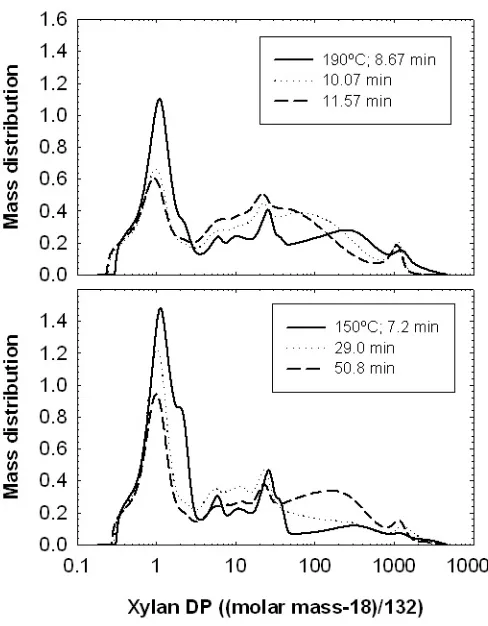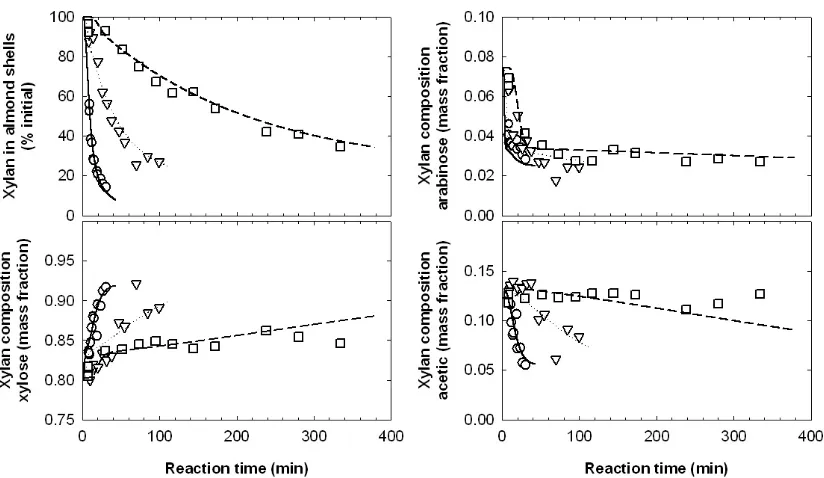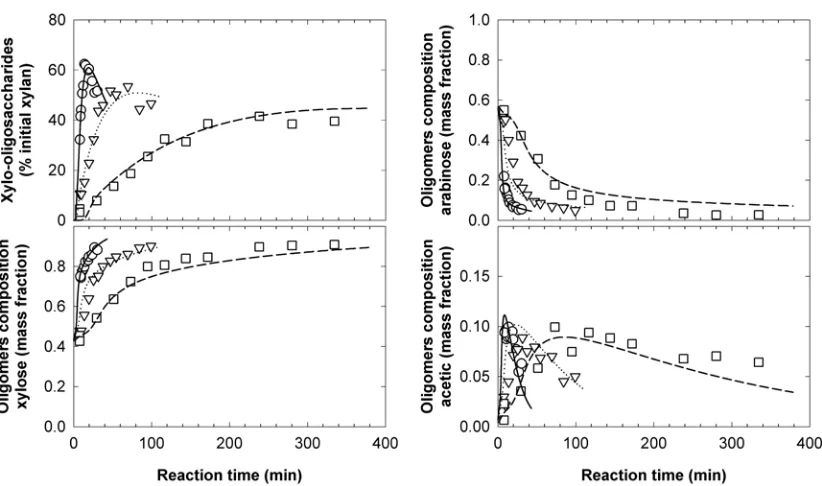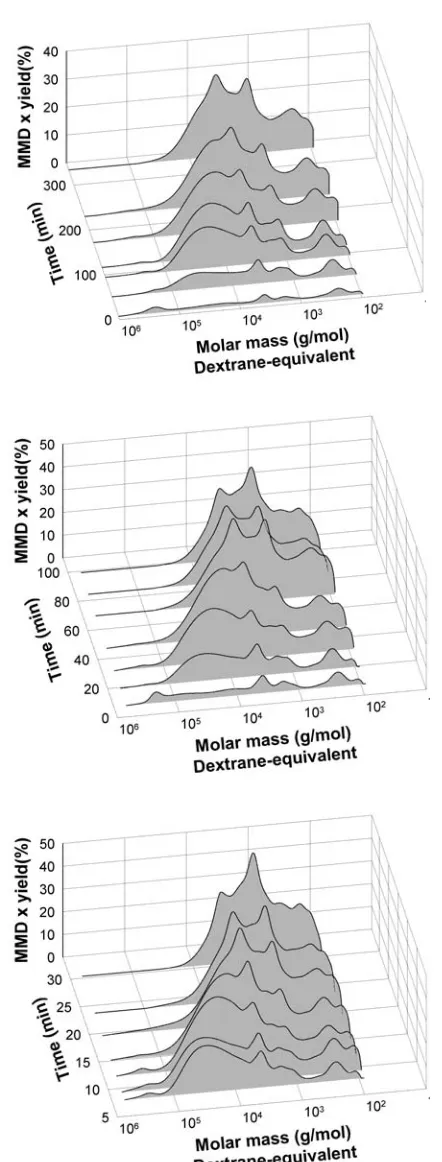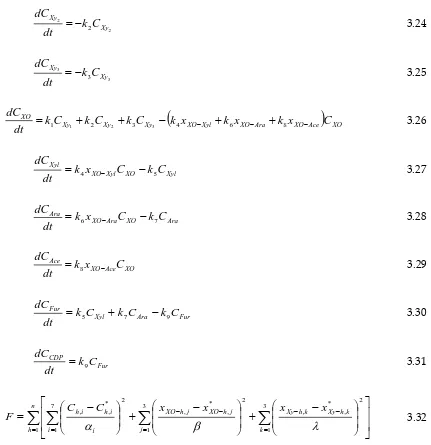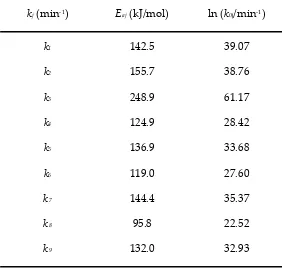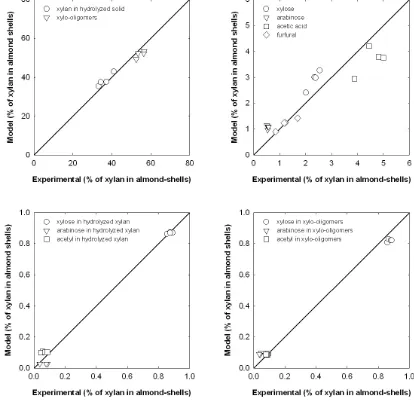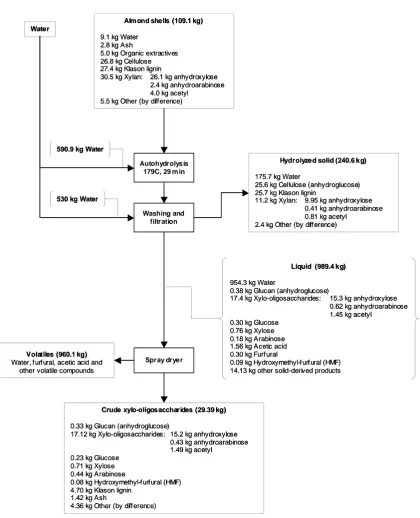UNIVERSITAT
ROVIRA
I
VIRGILI
Departament
d’Enginyeria
Química
AUTOHYDROLYSIS OF AGRICULTURAL
BY-PRODUCTS FOR THE PRODUCTION
OF XYLO-OLIGOSACCHARIDES
Dissertation
presented
by
DEBORA
ALCIDA
NABARLATZ
in
partial
fulfillment
of
the
requirements
for
the
degree
of
Doctor
by
the
Universitat
Rovira
i
Virgili
European
PhD
Supervised
by
Dr.
Daniel
Montané
i
Calaf
El sotasignant
FA CONSTAR
que el present treball, que porta per títol
AUTOHYDROLYSIS OF AGRICULTURAL BY‐PRODUCTS FOR THE
PRODUCTION OF XYLO‐OLIGOSACCHARIDES
i que presenta Debora Alcida Nabarlatz per optar al grau de Doctor per la Universitat
Rovira i Virgili, ha estat realitzat en aquesta Universitat sota la meva direcció, i que tots
els resultats presentats i l’anàlisi corresponent són fruït de la investigació realitzada per
l’esmentat candidat.
i per a què se’n prengui coneixement i als efectes que correspongui, signa aquest
certificat,
Dr. Daniel Montané i Calaf
Professor Titular
Departament d’Enginyeria Química Universitat Rovira i Virgili
MEMBERS OF THE ASSESSMENT COMMISSION
Dr. Mercedes Ballesteros Perdices
CIEMAT ‐ Centro de Investigaciones Energéticas, Medioambientales y
Tecnológicas, Spain.
Dr. Joan Salvadó
Universitat Rovira i Virgili, Spain.
Dr. Anna Ebringerová
Institute of Chemistry, Slovak Academy of Sciences, Slovakia.
Dr. Cristina Palet Ballús
Universitat Autónoma de Barcelona, Spain.
Dr. Montserrat Ferrando Cogollos
Universitat Rovira i Virgili, Spain.
Dr. Paloma Manzanares Secades
CIEMAT ‐ Centro de Investigaciones Energéticas, Medioambientales y
Tecnológicas, Spain.
Dr. Jan Hirsh
Institute of Chemistry, Slovak Academy of Sciences, Slovakia.
External reviewers
Dr. Alain Celzard
Université Henri Poincaré, France.
Dr. Francesco Zimbardi
ENEA, Italian Agency for New Technology, Energy and Environment, Italy.
En memoria de mi abuelo, don Miguel Tartaglio (Cholo).
Tarragona, 6 de Mayo de 2006
Balcarce, Abril de 1986
Era una noche de otoño, fresquita como siempre
cuando se empieza a acercar el invierno.... Yo contaba por
ahí unos 8 años, y aunque no lo recuerdo muy bien,
supongo que sería una noche de viernes, o un sábado,
cuando podía quedarme en su casa sin problemas para ir a la
escuela. Recuerdo que dormía con ellos en su habitación
(mis abuelos no me dejaban dormir sola), en mi cama con
sábanas blancas de algodón, colchón de lana, y una colcha
amarillita con flores rosadas. Mi abuelo me despertó
suavemente, y me dijo “Levantáte, nena”. Yo medio
adormilada, y sin entender nada (eran las 3 de la mañana en punto) me levanté, y lo seguí. Me
puse una campera encima del pijama, él también se abrigó, y juntos salimos al patio. Era una
noche estrellada como nunca. Empezó a buscarlo por ahí, y decía, “Puta, ya veo que no lo vamos
a poder ver”, rezongaba. Pero al cabo de unos minutos lo encontró, y me lo señaló. Nunca había
visto un cometa, y me sorprendió verle la colita, apenas perceptible, pero que demostraba que no
era como los demás. Que era diferente. Que era especial, y mi abuelo quería que yo lo viera junto
con él. Nunca olvidaré ese momento, y aún hoy, 20 años después, recuerdo esa noche como si
fuera esta noche. El silencio en el campo, el cielo lleno de estrellas, y el Halley brillando apenas
para nosotros. Quizá ahí haya comenzado todo, la verdad es que no lo sé. Hoy intento recordar
una escena típica entre nosotros, y esa es una de las mejores. También recuerdo todas las veces
que me decía, “Nena, estudiá, eso es lo único que nadie podrá quitarte”, y que con esa cantilena
me hinchó más de 20 años. Hoy te recuerdo, y te necesito, y este pequeño relato es un homenaje
para vos. Sé que estarás orgulloso ahí donde estés, y aunque ya hace 3 años que te fuiste quiero
que sepas que me seguís guiando como esa noche cuando era chica... Cuando te levantaste a las 3
AGRADECIMIENTOS
Antes que nada, quiero que sepan que esta etapa ha sido maravillosa para mí. Como la
mariposa, que siendo gusano se atreve a desplegar las alas, y mira al mundo maravillada
aunque sea solo por unas horas, así he sentido mi transformación durante estos últimos cuatro
años. En ese tiempo mucha gente ha pasado por mi vida, pocos significaron mucho, muchos
significaron poco, pero todos me rozaron y han dejado su marca (alguna más que indeleble) en
mí. A todos ustedes, gracias!!!!! Lo que leerán a continuación ha sido (sólo) una parte de mi
vida aquí.
Primero quiero agradecer tanto a los miembros del tribunal, como a los que evaluarán el
manuscrito para emitir el informe. Me siento orgullosa de que alguien se lea esto! Esto que me
ha brindado tantas penas y alegrías, tanta curiosidad y aburrimiento, y que no representa nada,
pero nada, de las horas de laboratorio, de los experimentos mal hechos, mal acabados, bien
hechos, bien acabados. Sólo es una selección (apta para la lectura) y un ensayo de muchos
aciertos y algunos errores, que espero corregir y mejorar en mi siguiente vida. Por su paciencia,
gracias!
A mi director de tesis, el Dr. Daniel Montané. Sé que no le gusta que le agradezca nada,
pero tiene que reconocer que gracias a usted aprendí ¡todo! lo necesario para poder empezar y
ahora continuar en este camino. Ha sido el mejor jefe que hubiera podido tener. Gracias!
A la Generalitat de Catalunya, gracias por el apoyo económico recibido durante estos
cuatro años. También a la Universitat Rovira i Virgili, y especialmente al Departament
d’Enginyeria Química, porque ha sido mi hogar y sus pasillos estarán siempre en mi memoria.
Especialmente quiero agradecer al Dr. Ioanis Katakis y al Dr. Azael Fabregat, porque fueron
quienes me dieron la oportunidad de venir a Tarragona y me acompañaron en el aterrizaje.
Muchas gracias también a la Dra. Flor Siperstein, Dra. Vanessa Fierro y Dra. Ana Lea
Cukierman por la magnífica posibilidad que me han brindado de formar parte del proyecto
Lignocarb. También quiero agradecer a todos aquellos que han colaborado en el desarrollo de esta
Special thanks to Dr. Anna Ebringerová. Thanks for your inconditional help, advices,
your happiness, and all the good time that we had in Bratislava. I want to thanks also to all the
people from the Institute of Chemistry, specially to Dr. Anna Malovíková, Dr. Alzsbeta (Betka)
Kardosová and Nadezda (Natka) Sporanková for their patience, love and special care during my
stay. Thanks Natka for make me feel as part of your family. Thanks to all the other people that
collaborated with my work there, Dr. Zdenka Hromadková, Eva, Slávka, and many others. I
want to thanks also to my colleagues and lunchmates, specially Rucho, Katy and Sylvia, which
taught me the ¡stone, paper, scissor!… I want to thanks to my friends from the residence,
Jadwiga, Julia, Katrine, and specially to Jana, which was my best friend for the trips around the
forest, and to walk, walk and walk. Thanks for the tiramisu party!!!!
Gracias también a quienes me formaron y me prepararon para poder completar esta
etapa con éxito. Entre ellos quiero agradecer especialmente a la Dra. Patricia Haure, quien me
brindó la posibilidad y el apoyo necesarios para venir a Tarragona. También a quienes me
formaron y su imagen quedó grabada para siempre, entre ellos la Dra. Rosa Fenoglio, Dra.
Claudia Bidabehere, Dra. Norma Marcovich, Dra. Mirta Aranguren, y muchos otros...
A mis compañeros y amigos del grupo Biopolímeros Vegetales. No sólo a los de ahora,
sino a todos los que han estado y pasado por allí durante todos estos años. Especialmente a Pepa
(que sería de nosotros sin ti, amiga mía), a Ana (compartimos un año fantástico), Carles,
Modest, Jordi, Luizildo, Jor, Freddy, Baltazar, Nour‐eddine, Xiao, Dayiong, Ïu, Vannessa, José
Antonio, Dawitt, Gautier, Camilo, Guillermo, Lulú, etc., etc., etc. También a los jefes, Xavier,
Ricard, Joan, Vanesa y Francesc, con quienes hemos compartido no sólo el trabajo sino también
más de una calçotada y paella.
También quiero nombrar a mis amigos, quienes han sido un poco ”mi familia” durante
estos últimos cuatro años. A toda la trouppe venezolana, especialmente a María Eugenia y
Pedro, y Carmelo, y también a Alicia por los momentos compartidos. A Gus, compañero de
domingos ya lejanos. A papá Henry y mamá Jor por cuidar de mí, y a los compis de café,
A Fredyto, eterno navegante, mi diaria alegría, amor inconmensurable, paciencia
infinita. Que tu puerto sea mi puerto, allí donde la vida nos lleve... y que el destino nos una para
siempre...
A mis amigas y amigos que quedaron lejos y aún así permanecieron fieles a la amistad.
La lista es enorme, lo saben, pero hay gente más que especial. Fundamentalmente tuve la suerte
de contar con Vero y mi adorada sobrina Agustina, con Andrea, con Leo, y mi prima Silvana y
su hija (mi ahijada) Martina, luz de mi corazón. A Carlitos y Vicky por los asados, charlas y
momentos compartidos. También a Lucrecia, Mariana, Laura, Silvana y Solange, compañeras
de carrera, y años de universidad, y ahora amigas desparramadas por el mundo. A Paola, con
quien compartí tres meses de locas aventuras. A ellas, mujeres valerosas y con un corazón de
oro, gracias por estar ahí siempre!!!
Dentro de mis amigas, Jorgelina merece un párrafo aparte. ¿Qué hubiera sido de mí sin
ti, eh?. Has sido madre, hermana, amiga, juez y parte en cada uno de los acontecimientos en los
últimos diez años. Gracias a vos vine acá, permanecí acá y sobreviví acá. No lo olvidaré nunca.
Gracias Jor!
A mi madre. Porque ha sido y sigue siendo mi ejemplo de lucha, amor, paciencia,
optimismo y buena voluntad. Porque siempre respetaste mis decisiones y me apoyaste, muchas
veces sabiendo que me equivocaba, y aún así después me ayudaste a levantarme cuando estaba
en el suelo. A Osvaldo, gracias por ser mi padre y acompañarme como tal estos últimos 12 años.
A mis hermanas Virginia (quien pronto me hará tía), y María por su amor, cariño, alegría, y
por estar conmigo siempre (saben que las adoro). A mis abuelos Olga y Cholo, por criarme,
apoyarme y alentarme en mi búsqueda, especialmente a mi abuelo Cholo por todo su amor. Al
resto de mi familia, (la grande y la chica), mis tíos y mis primos, mis tíos y tías abuelos, y a todo
aquel que siempre le pregunta a mi mamá, ¿Cómo está la Débora?.
A todos los que de una manera u otra no sólo han colaborado con este trabajo, sino
conmigo, a todos aquellos que me han apoyado y ayudado, aguantando lloradas, extrañitis,
melancolías y nostalgias. A todos ustedes, y todos ellos, ¡Gracias! Esta será una etapa que no
INDEX
List of Figures……….………… xv
List of Tables………... xx
Nomenclature……….………… xxi
Summary ………...……….………… xxv
Resumen………... xxvi
Scope of the thesis……….. xxxiii
Chapter 1. Introduction……….………… 1
1.1. The oligosaccharides and their main applications……….. 1
1.1.1. Applications of oligosaccharides as food additives………. 1
1.1.2. Applications of oligosaccharides in the pharmaceutical field…….………... 5
1.2. The chemical structure of xylo‐oligosaccharides……….………… 7
1.2.1. Xylan characteristics……….. 8
1.3. Hemicelluloses as component of wood……….………... 11
1.3.1. Chemical composition of wood……….. 11
1.3.2. Anatomical structure of wood………. 16
1.4. Processes for the industrial production of hemicelluloses…………..…………... 19
1.4.1. Hydrothermal treatments……….………… 22
1.4.2. Acid/Alkaline hydrolysis……….. 26
1.4.2.1. Mechanism of acid hydrolysis of hemicelluloses……….……….. 27
1.4.2.2. Mechanism of alkaline hydrolysis of hemicelluloses………. 29
1.4.3. Enzymatic treatments……… 32
1.4.3.1. Mechanism of enzymatic hydrolysis……….………... 35
1.4.4. Organosolv treatments……….. 37
1.5. Recovery and purification of oligosaccharides……… 38
1.5.1. Extraction with organic solvents………. 39
1.5.2. Adsorption processes……… 40
1.5.3. Membrane separation process………. 41
1.5.4. Evaporation and drying processes………. 42
1.5.5. Ionic exchange resins……….………... 42
1.6. References……….. 43
2.1. Autohydrolysis reaction……….. 55
2.1.1. Autohydrolysis reaction at small scale………... 55
2.1.2. Autohydrolysis reaction in the 10 L reactor……….. 57
2.1.3. Analysis of the samples……….………... 59
2.1.3.1. Analysis of the raw materials……….………... 59
2.1.3.2. Analysis of the solid residue obtained after the reaction……….. 60
2.1.3.3. Analysis of the autohydrolysis liquor……….. 61
2.2. Purification of the XOs……….………... 63
2.2.1. Ultrafiltration using polymeric membranes……….. 63
2.2.1.1. Retention of impurities and separation of different molecular weight fractions……… 63
2.2.1.2. Fouling experiments……….……….. 65
2.2.2. Adsorption on activated carbon……….. 66
2.2.2.1. Equilibrium tests……….. 67
2.2.2.2. Adsorption on activated carbon in a column……….. 67
2.2.2.3. Characterization of the activated carbon………. 68
2.2.3. Precipitation with a non solvent……….. 69
2.2.4. Enzymatic membrane reactors……….………... 70
2.3. Recovery of the XOs……….………… 71
2.3.1. Spray‐drying………... 71
2.3.2. Lyophilization……….………... 72
2.4. Preparative procedures………... 73
2.4.1. Dialysis process used for purification of SXOs………. 73
2.4.2. Purification with Amberlite XAD ‐ 2 resin………... 74
2.5. Analytical methods……….. 75
2.5.1. Ash content determination (ASTM D‐1102‐84)……….………… 75
2.5.2. Moisture content determination………..………… 76
2.5.3. Removal of the organic extractives (ASTM D‐1107‐84 modified)………….. 76
2.5.4. Determination of the Klason lignin (ASTM D 1106‐84)………... 76
2.5.5. Analysis of the XOs recovered……….………… 77
2.5.6. Posthydrolysis reaction for the quantification of total monomers.………… 77
2.5.6.1. Posthydrolysis of samples from autohydrolysis liquor………. 77
2.5.6.2. Posthydrolysis of SXOs and DXOs………... 77
2.5.8. Determination of the acid – soluble lignin……….………… 79
2.5.9. Determination of uronic acid……….. 79
2.5.9.1. Determination by colorimetry………... 79
2.5.9.2. Determination by potentiometry……….. 79
2.5.10. Determination of ferulic acid………. 80
2.5.11. Procedure for the solvent extraction ‐ Determination of phenolic acid….. 81
2.5.12. Deacetylation reaction……….………… 81
2.5.13. Methods for qualitative identification……….. 82
2.5.13.1. Descending Paper Chromatography……….. 82
2.5.13.2. TLC (Thin Layer Chromatography)……….……….. 82
2.5.14. Antioxidant activity of xylo‐oligosaccharides……….………… 82
2.5.15. Mitogenic and comitogenic activity testing………. 83
2.5.16. Instrumental methods……….………… 84
2.5.16.1. High Pressure Liquid Chromatography Analysis………….………... 84
2.5.16.2. Gel Permeation Chromatography………... 87
2.5.16.3. Nuclear Magnetic Resonance (NMR) analysis……….. 88
2.5.16.4. FT‐IR and MALDI‐TOF Mass Spectrometry………. 92
2.6. References……….. 93
Chapter 3. Results and Discussion………... 97
3.1. Autohydrolysis of corncobs and almond shells……….. 99
3.1.1. Raw material composition……… 99
3.1.2. Composition of the solid residue after autohydrolysis……… 100
3.1.3. Autohydrolysis of corncobs………. 104
3.1.3.1. Product distribution and reaction pathway……… 104
3.1.3.2. Kinetics of xylan depolymerization……….. 110
3.1.4. Autohydrolysis of almond shells……… 117
3.1.4.1. Product distribution and reaction pathway……… 117
3.1.4.2. Kinetics of xylo‐oligosaccharides formation………... 122
3.1.4.3. Large‐scale experiments………. 127
3.2. Autohydrolysis of different agricultural by‐products……… 132
3.2.1. Autohydrolysis‐induced compositional changes………. 132
3.2.1.1. Composition of the raw materials………. 132
3.2.1.2. Cellulose component………... 133
3.2.1.4. Xylan component………. 135
3.2.2. Molar mass distribution of the xylo‐oligosaccharides………. 139
3.2.3. Structural features of the xylo‐oligosaccharides………... 140
3.2.4. Characterization of xylo‐oligosaccharides from almond shells……….. 145
3.3. Purification treatments……… 153
3.3.1 Precipitation with a non solvent………... 153
3.3.2. Removal of lignin impurities by adsorption onto activated carbons………. 156
3.3.2.1. Adsorption equilibrium tests………. 156
3.3.2.2. Column tests………. 167
3.3.3. Ultrafiltration of xylo‐oligosaccharides from almond shells……….. 172
3.3.3.1. Composition of the crude xylo‐oligosaccharides from almond shells 173 3.3.3.2 Ultrafiltration of the xylo‐oligosaccharides solution………... 175
3.3.4. Enzymatic membrane reactors……… 187
3.4. Preliminary results about possible applications of xylo‐oligosaccharides…….. 190
3.4.1. Antioxidant activity of the xylo‐oligosaccharides……… 190
3.4.2. Immunomodulatory activity of almond shells xylo‐oligosaccharides…….. 191
3.5. References……….. 193
Chapter 4. Conclusions and Future Work……….…. 201
4.1. Conclusions………... 201
4.2. Recommendations.………... 204
LIST OF FIGURES
Figure 1.1. Main applications of oligosaccharides……….. 1
Figure 1.2. Formulas of the sugar components of polyoses……….. 7
Figure 1.3. a) Partial chemical structure of O‐acetyl‐4‐O‐methylglucuronoxylan from
hardwood (MGX). b) Partial chemical structure of arabino‐4‐O‐methylglucuronoxylan
(AGX) from softwood. c) Partial chemical structure of arabino‐xylooligosaccharide (AX)
from wheat bran hemicellulose. d) Partial chemical structure of arabinoxylan (AX) from
grasses……….… 10
Figure 1.4. a) General scheme showing the chemical composition of wood. b) Approximate
distribution of the macromolecular substances in wood……….... 12
Figure 1.5. Formula of cellulose. a) Central part of the molecular chain. b) Reducing and
non reducing end group of the molecule of cellulose………. 13
Figure 1.6. Building units of lignin: p‐coumaryl alcohol (I), coniferyl alcohol (II), sinapyl
alcohol (III)………. 14
Figure 1.7. Structural scheme of lignin……….. 14
Figure 1.8. Schematic illustration of connections between softwood polyoses and lignin…... 15
Figure 1.9. Most frequently suggested types of lignin‐polysaccharide linkages……… 15
Figure 1.10. Models of a softwood and a hardwood block, showing the main cutting planes
for anatomical studies, and anatomical structures visible without optical aids………. 17
Figure 1.11. Representation of the cell wall structure of softwood tracheids and hardwood
libriform fibres……….….. 18
Figure 1.12. Comparison between the cell wall of tracheids, fibres and vessels with that of
parenchyma cells………... 19
Figure 1.13. Main processes used in the fractionation of biomass……… 20
Figure 1.14. Mechanism of acid hydrolysis of glycosidic linkages………... 27
Figure 1.15. Half‐chair conformation of the tautomeric carbonium‐oxonium ion pair………. 28
Figure 1.16. Formation of furfural, hydroxymethylfurfural, levulinic acid and formic acid
from monosaccharides in acidic medium………. 29
Figure 1.17. Endwise degradation of polysaccharides. a) reactions involved in peeling, b)
main stopping reactions………... 31
Figure 1.18. Hydrolysis of glycosidic bonds in alkaline medium………. 32
Figure 1.19. A hypothetical plant heteroxylan fragment and the sites of attack by
xylanolytic enzymes………. 34
Figure 1.20. Activity mechanism of the different enzymes on arabinoglucuronoxylan,
arabinoxylan, and glucuronoxylan……….... 36
Figure 1.21. Main methods used for the purification of oligosaccharides………... 38
Figure 2.1. Small reactors………. 55
Figure 2.2. Typical temperature profile for the experiments in the 10 L reactor……… 56
Figure 2.3. Scheme of the 10 L reactor system……….. 59
Figure 2.4. Equipment used for the membrane separation process……….. 64
Figure 2.5. Module used for the separation using polymeric membranes……….. 65
Figure 2.6. Spray drying equipment……….. 72
Figure 2.7. Lyophilization equipment………... 73
Figure 2.8. Dialysis process used for purification of xylo‐oligosaccharides……… 74
Figure 2.9. Equipment used for HPLC/GPC………….……… 84
Figure 2.10. a) Chromatogram obtained with the RID detector for a sample of autohydrolysis liquor of almond shells after posthydrolysis treatment. b) Chromatogram obtained for the analysis of the different standards used.……….. 85
Figure 2.11. a) Calibration curve for the standards of glucose, xylose, arabinose and acetic acid obtained with the RID detector. b) Calibration curve for the standards HMF and furfural obtained with the RID detector……… 86
Figure 2.12. Typical Molar Mass Distribution (MMD), obtained for a mixture of XOs from almond shells after spray‐drying process………. 87
Figure 2.13. Calibration curve for GPC analysis……….. 88
Figure 2.14. Different spectra for DXOs from almond shells………. 91
Figure 3.1. Composition of the solid residue after the reaction from corncobs and almond shells, for different temperatures as function of the reaction time……… 100
Figure 3.2. Variation in the composition of the xylan remaining in the solid residue after the reaction, for different temperatures as function of the reaction time: anhydroxylose, anhydroarabinose and acetyl (as wt.% of xylan)………. 102
Figure 3.3. pH of the resultant liquid after the reaction, as function of temperature and reaction time……….. 103
Figure 3.4. Distribution of the cellulose products in the liquid after the reaction (as % of the original cellulose), as function of temperature and reaction time: gluco‐oligosaccharides, glucose and HMF……….. 104
Figure 3.5. Yield and compositions of the xylan remaining in the hydrolyzed corncobs……. 105
Figure 3.6. Yield and compositions of the xylo‐oligosaccharides from corncobs………... 106
Figure 3.7. Yields of xylose, arabinose, acetic acid and furfural during corncobs autohydrolysis………... 107
Figure 3.8. Molar mass distributions of the soluble products for the experiments performed at 190°C and 150°C and short reaction times……… 109
Figure 3.9. Reaction pathway for xylan autohydrolysis from corncobs………... 110
Figure 3.10. Amount and composition of the unreacted xylan remaining in the hydrolyzed
almond shells………. 117
Figure 3.11. Yield and composition of the xylo‐oligosaccharides………. 118
Figure 3.12. Change in the molar mass distribution of the xylo‐oligosaccharides during
autohydrolysis at 150°C, 169°C and 190°C………... 120 Figure 3.13. Yields of xylose, acetic acid, arabinose and furfural, and the amount of
degraded xylan……….. 121
Figure 3.14. Reaction pathway for the autohydrolysis of xylan from almond shells…………. 122 Figure 3.15. Autohydrolysis of almond shells in the 10L stirred reactor at 179°C.
Comparison between the experimental yields and compositions and the values calculated
with the kinetic model for xylan, xylo‐oligosaccharides, and monomer products………. 128 Figure 3.16. Yields and compositions for the autohydrolysis of almond shells at 179°C and
29 min and the recovery of the crude xylo‐oligosaccharides by spray drying……… 129 Figure 3.17. Molar mass distribution of the crude xylo‐oligosaccharides in the
autohydrolysis liquor and after recovery by spray drying, determined by GPC………... 130 Figure 3.18. Distribution of cellulose among reaction products: hydrolysis residue
(cellulose) and liquid products (gluco‐oligosaccharides, glucose and HMF), expressed as %
of original cellulose in the different raw materials……….. 134 Figure 3.19. Distribution of lignin among reaction products: hydrolysis residue (Klason
Lignin), and liquid products (acid – resistant and acid – soluble lignin), expressed as % of
original Klason lignin + organic extractives in the different raw materials………. 135 Figure 3.20. Hemicellulose in the raw material and its distribution between the hydrolysis
residue and the non‐dried liquid products (XOs, monosaccharides, acetic acid and
furfural), expressed as % of original hemicellulose in the different raw materials……… 136 Figure 3.21. Molar mass distribution of the xylo‐oligosaccharides in the non‐dried liquid
product (XOs), obtained after spray drying (SXOs) and obtained after dialysis (DXOs), for
the six raw materials studied……….. 140 Figure 3.22. 13C NMR spectra (in D2O) of DXOs from various plant sources……….. 141
Figure 3.23. 1H NMR spectra of XOs from barley straw and corncobs……… 142
Figure 3.24. The 2D HSQC spectrum of DXOs from olive stones, illustrating MeGA
residues and various Xylp residues……… 143 Figure 3.25. FT‐IR spectra of the crude almond shell SXOs and its purification products…… 147 Figure 3.26. 13C NMR spectra (in D2O) of (A) dialyzed almond shell xylo‐oligosaccharides (DXOs) and (B) the deacetylated sample (DeXOs)……….. 148 Figure 3.27. Partial 1H/13C HSQC NMR spectrum (in D2O) of almond shell DXOs…………... 149 Figure 3.28. MALDI ‐TOF mass spectrum in D2O (sodium‐adducts) of the deacetylated
sample (DeXO)……….. 151
Figure 3.29. MALDI ‐TOF mass spectrum (sodium‐adducts) of almond shell xylo‐
oligosaccharides DXOs……… 152
Figure 3.30. Alcoholic precipitation………... 153
Figure 3.31. Comparison of the molar mass distribution of the soluble products presents in
the hydrolysis liquor and that of the xylo‐oligosaccharides recovered by ethanol
precipitation………... 155
Figure 3.32. GPC chromatograms (time in log‐scale) for the xylo‐oligosaccharides
remaining in solution in the equilibrium adsorption experiments at 30°C and different
loads of the AC‐1 activated carbon……… 158
Figure 3.33. Relation between the reduction in the concentrations of lignin‐derived
phenolics and carbohydrates at equilibrium for various loads of activated carbon at 30°C…. 159
Figure 3.34. Pore volume distributions for the three activated carbons used in this study….. 162
Figure 3.35. Freundlich isotherms for the adsorption of lignin‐derived phenolics (open
symbols) and xylo‐oligosaccharides (solid symbols) on the three activated carbons at 30°C.. 165
Figure 3.36. Variation in the constants of the Freundlich isotherms of lignin‐derived
compounds (KLP) and xylo‐oligosaccharides (KXO) with the surface properties of the
activated carbons……….. 166
Figure 3.37. Adsorption of the crude xylo‐oligosaccharides from reaction batch 2 on an AC‐
1 activated carbon column: breakthrough curves for carbohydrates and lignin‐derived
products.……….……… 168
Figure 3.38. Adsorption of the crude xylo‐oligosaccharides from reaction batch 2 on an AC‐
1 activated carbon column: GPC chromatograms (time in log‐scale) for the xylo‐
oligosaccharides remaining in solution………. 169
Figure 3.39. GPC elugrams of the lignin‐related products and the xylo‐oligosaccharides in
the feed and permeate of the GE – 1 kDa membrane at the different pressures tested………. 176
Figure 3.40. Influence of pressure on the fluxes of water and xylo‐oligosaccharides solution
for the thin‐film ultrafiltration membranes……….. 178
Figure 3.41. Influence of pressure on the fluxes of xylo‐oligosaccharides and lignin‐related
products……….. 179
Figure 3.42. Relationship between the dimensionless selectivity towards permeation of the
lignin‐related products and the flux of permeate……… 180
Figure 3.43. Ultrafiltration of xylo‐oligosaccharides: observed rejection curves for the four
polymeric membranes (dextran‐equivalent molar masses)………... 181
Figure 3.44. Relationship between the nominal MWCO of the membranes, and their
apparent MWCO established from the molar mass distribution of the permeated xylo‐
oligosaccharides……… 182
Figure 3.45. Membrane fouling: relationship between the water permeabilities of new and
used membranes………... 182
Figure 3.46. GPC elugrams of the lignin‐related products and the xylo‐oligosaccharides in
the feed and permeate of the GE – 1 kDa membrane as function of time for the fouling
experiments……… 183
Figure 3.47. Influence of time in the fluxes of lignin‐derived products and xylo‐
Figure 3.48. a) Comparison between the monomers content (glucose, xylose and arabinose)
and acetic acid, between the feed and permeate collected during 5 h of experiment. b)
Comparison between the oligosaccharides content (glucose, xylose and arabinose) and
acetic acid, between the feed and permeate collected during 5 h of experiment. c)
Comparison of the uronic acid, furfural and HMF between the feed and permeate collected
during 5 h of experiment………. 186 Figure 3.49. (a) GPC signal of the dextran (40 kDa) solution, the enzyme dextranase, and
the samples of the mixture taken at different reaction times. b) GPC signal showing the
activity of the enzyme‐carbon complex, at different pH and different ratios carbon/enzyme. 188 Figure 3.50. GPC signal of the experiments for the EMR. Up: Feed (solution of dextran,
MW: 40 kDa). Down: Permeate collected at different reaction times………... 189
LIST OF TABLES
Table 2.1. Reaction times at constant temperature for the experiments at small scale…….. .. 57
Table 2.2. Assignments for the 13C signals (up) and 1H signal (down) for each different
carbon in the molecule……… 89
Table 3.1. Average chemical composition and confidence interval (α=0.025) of the batch of
corncobs and almond shells used for this study………. 99
Table 3.2. Best‐fit values for the activation energies and the frequency factors of rate
constants k1 to k8 (min‐1)………... 116
Table 3.3. Best‐fit values for the amounts and compositions of the two types of xylan in
native corncobs……… 116
Table 3.4. Best‐fit values for the activation energy and the frequency factor of the rate
constants k1 to k9. (min‐1)……….. 126
Table 3.5. Best‐fit values for the amount and composition of the three types of xylan in
native almond shells……… 126
Table 3.6. Composition of the different raw materials (wt.%) , related to dry material, with
confidence interval (α = 0.025)………... 132
Table 3.7. Composition of the spray – dried liquid product (SXOs)………... 138
Table 3.8. Relative amounts of monosaccharides and acetyl groups, and distribution of
acetyl groups among xylose residues in the DXOs from different raw materials………. 144
Table 3.9. Chemical characteristics of the crude (SXO) and dialyzed XO (DXO) obtained
from almond shells……….. 146
Table 3.10. HSQC NMR cross‐peaks of various structural elements of almond shell DXO… 150
Table 3.11. Surface characteristics of the commercial activated carbons (NORIT) used in
this study………... 161
Table 3.12. Freundlich isotherms: results for the adsorption of the carbohydrate fraction
and the lignin‐derived products on commercial activated carbons……… 164
Table 3.13. Adsorption on an AC‐1 activated carbon column: composition of the
lyophilized samples of the product fractions collected during the experiment and
retentions calculated for xylo‐oligosaccharides and lignin‐related products (Xylo‐
oligosaccharide solution from reaction batch 2)………. 171
Table 3.14. Autohydrolysis of almond shells at 179°C and 29 min: yields and composition
of the products (based on 100 kg of dry almond shells)……… 174
Table 3.15. Water permeability for the clean membranes……… 177
Table 3.16. Antioxidant activity for XOs from the different raw materials……… 190
Table 3.17. Mitogenic and comitogenic activities of partially O‐acetylated xylo‐
oligosaccharides from almond shells (AS‐DXO) and corncobs (CC‐DXO) in comparison to
the corncob xylan (CCX) used as positive control……….. 192
NOMENCLATURE
13C: One dimensional carbon spectra.
1H: One dimensional proton spectra. AA: Antioxidant activity.
AGX: arabinoglucuronoxylan.
AS: almond shells.
AS‐DXO: dialyzed xylo‐oligosaccharides from almond shells.
AX: arabinoxylan.
B: Concentration of lignin obtained by spectrophotometry (g/l).
BS: barley straw.
C0,j: concentration of solute in the feed (g/L) CC: corncobs.
CC‐DXO: dialyzed xylo‐oligosaccharides from corncobs.
CCX: immunogenic water‐soluble arabinoglucuronoxylan from corncobs. Ce,j: equilibrium concentration of species j in the solution (g/L).
CHX: complex heteroxylan.
Cj: concentration of the species j expressed as a mass percent of the initial xylan that has been converted into the species j.
CLP and CXO: total concentrations of lignin‐related products and XOs in the permeate. CLP‐feed and CXO‐feed: total concentrations of lignin‐related products and XOs in the feed.
COMPi: Mass of component i (g) in dry basis obtained by HPLC analysis in the case of glucose, xylose, arabinose, acetic acid, furfural and HMF; and obtained by weight in the case of Klason
lignin.
CSe,j: concentration of solute j adsorbed on the activated carbon at equilibrium (g/gAC). CXO,M: concentration of a xylo‐oligosaccharide of mass M in the permeate.
CXO‐feed,M: concentration of a xylo‐oligosaccharide of mass M in the feed.
CXy[0]: total amount of xylan.
CXyi[0]: amount of the type of xylan i present in the native raw material. DeXO: Deacetylated xylo‐oligosaccharides.
DFT: Density Functional Theory model.
DP: Degree of polymerization.
DS: Mass of original dry solid (g).
DSAc: degree of acetylation.
DXOs: dialyzed xylo‐oligosaccharides.
Eai: Activation energy of the rate constants (kJ/mol). EAS: water‐soluble phenolic fraction.
EMR: Enzymatic Membrane Reactor. f: sugar unit in furanose form.
FOS: fructo‐oligosaccharides.
Fuc: Fucose.
Gal: Galactose.
GAX: glucuronoarabinoxylan.
Glc: Glucose.
GOS: gluco‐oligosaccharides.
Hex: hexose unit.
HMF: hydroxymethylfurfural.
HSQC: Heteronuclear Single Quantum Correlation spectra. ki: specific reaction rates (min‐1).
Kj: unit‐capacity parameter, for xylo‐oligosaccharide adsorption (KXO) and for lignin‐derived phenolics (KLP).
LO: % of soluble lignin associated based on xylo‐oligosaccharides precipitated.
LP: liquid product.
m: mass of activated carbon (gAC). M: Molar mass (g/mol).
Man: Mannose.
MeS: water‐insoluble phenolic fraction.
MGA or MeGA: 4 ‐O‐ methyl‐D‐glucuronic acid.
MGX: methylglucuronoxylan.
ML: middle lamella.
MMD: Molar mass distribution.
MON_OCi: % of monomers presents in the autohydrolysis liquor (glucose and HMF), based on original cellulose.
MON_OMi: % of monomers presents in the autohydrolysis liquor (glucose, xylose, arabinose) and furfural, acetic acid, and HMF, based on 100 g of original dry material.
MON_OXi: % of monomers presents in the autohydrolysis liquor (xylose, arabinose and acetic acid), based on original xylan.
MW: molecular weight.
NMR: Nuclear Magnetic Resonance.
NSP: non‐starch polysaccharides.
OLIG_COMPi: Composition of oligosaccharides in % (xylose, arabinose and acetic acid). OLIG_OMi: % of component i (xylose, arabinose or acetic acid) that form part of xylo‐ oligosaccharides, based on 100 g of original dry material.
OLIG_OXi: % of component i (xylose, arabinose or acetic acid) that form part of xylo‐ oligosaccharides, based on original xylan.
OLIG_TOT: Total amount of xylo‐oligosaccharides based on original xylan.
OS: olive stones.
P: primary wall.
p: sugar unit in pyranose form.
PO: Mass of oligosaccharides precipitated (g).
PREC_OM: Yield of precipitated oligosaccharides based on 100 g of original dry material.
PREC_OX: Yield of precipitated oligosaccharides based on original xylan.
PuXOs: purified XOs.
PZC: point of zero charge.
rdj: reductions in the concentrations of lignin‐derived products and carbohydrates. RH: rice husks.
Rha: Rhamnose.
RI: Refraction Index signal, for permeate and retentate.
Robs,M: retention for a xylo‐oligomer with a molar mass of M. RS: resistant starch.
S: Mass of dried solid used for Klason lignin analysis (g).
S1: secondary wall one.
S2: secondary wall two.
SB: % of solubilized solid.
SLP/CH: Selectivity of the membrane.
SOL_OCi: % of component i in the hydrolyzed solid, based on % of component i in raw material (for lignin, cellulose and xylan).
SOL_OMi: % of component i in the hydrolyzed solid, based on 100 g of original dry material (for lignin, cellulose and xylan).
SOL_RAWi: % of component i in raw material for lignin and cellulose. In the case of xylan, it is calculated as a sum of the corresponding percentages of xylose, arabinose and acetic acid in raw
material.
SXOs: spray ‐ dried xylo‐oligosaccharides.
T: tertiary wall.
t: time (min).
V: Volume of solution (L).
W: wart.
WS: wheat straw.
X2: 2‐O‐acetylated xylose unit.
X23: 2,3‐di‐O‐acetylated xylose unit.
X3: 3‐O‐acetylated xylose unit.
XG: MeGA 2‐O‐linked to a xylose unit.
XG3: MeGA 2‐O‐linked and 3‐O‐acetylated xylose unit.
Xint: non‐substituted internal xylose unit.
Xn: neutral xylo‐oligosaccharides.
XnAcm: neutral xylo‐oligosaccharides with one to two acetyl groups. XnMeGA: acidic xylo‐oligosaccharides branched with one uronic acid.
XnMeGAAc: acidic oligomers containing one acetyl group with one uronic acid. XOS: xylo‐oligosaccharides.
Xt: non‐reducing terminal xylose unit.
xXO‐Ace: mass fractions of acetyl in the average composition of the oligomers.
xXO‐Ara: mass fractions of anhydroarabinose in the average composition of the oligomers.
xXO‐Xyl: mass fractions of anhydroxylose in the average composition of the oligomers.
xXyi‐Xyl, xXyi‐Ara and xXyi‐Ace: compositions of the different xylan fractions, for xylose, arabinose and acetyl groups.
xXy‐Xyl[0], xXy‐Ara[0] and xXy‐Ace[0]: composition of the original xylan, for xylose, arabinose and acetyl groups.
XYL_OMi: % of component i (xylose, arabinose or acetic acid) in the hydrolyzed solid, based on 100 g of original dry material.
XYL_OXi: % of component i (xylose, arabinose or acetic acid) in the hydrolyzed solid, based on original xylan.
XYL_RE: Total xylan remaining in the hydrolyzed solid based on original xylan.
XYL_RE_COMPi: % of component i (xylose, arabinose or acetic acid) in xylan remaining in the hydrolyzed solid.
Xα: Reducing end α of a xylose unit.
Xβ: Reducing end β of a xylose unit.
SUMMARY
Lignocellulosic biomass is a fully renewable resource that can be used as raw
material for the production of a wide variety of compounds, such as biomass‐derived
fuels, power, chemicals or materials. In the present research, agricultural residues
typical from the Mediterranean region of Spain, were used for the production of xylo‐
oligosaccharides with potential applications in the food and pharmaceutical field.
Autohydrolysis reaction was tested at several temperatures and reaction times to
produce these xylo‐oligosaccharides. It was found that the increase in the temperature
and longer reaction times increased the depolymerization of xylan and the formation
of low molar mass products. Cellulose and lignin remained quantitatively in the solid,
which suggests that the solid residue could be used to recover them in a subsequent
step. The maximal yield of xylo‐oligosaccharides was around 63 wt% for almond shells
at 190°C and 19 min of reaction. The molar mass distribution of the products was very
broad (between 100 to 106 g/mol), being strongly dependent on the reaction conditions and the raw material used.
All the xylo‐oligosaccharides obtained by autohydrolysis reaction showed
structural features of a partially O‐acetylated 4‐O‐methylglucuronoxylan with different degrees of substitution depending on the raw material where they came from.
Several purification methods were tested for the removal of impurities and/or
separation in different molecular weight fractions. The precipitation using a non
solvent allowed to recover between 85% and 95% of the theoretical xylo‐
oligosaccharides for corncobs and almond shells, respectively, obtained at 169°C and
25 min of reaction. The yield of product precipitated tended to be much lower at higher
reactions times, since the low molar mass oligomers and monomers were soluble in the
ethanol‐water mixture.
The ultrafiltration using polymeric membranes seems the most promising
different molecular weight fractions. The results obtained demonstrated that the 1 kDa
membrane was the more selective for the removal of lignin‐derived impurities. It was
also observed that the increase in the pressure of operation decrease the selectivity, and
for this reason the membranes should be operated at low pressure to maximize it,
although this will imply a larger area for the same flow rate of permeate.
The adsorption of impurities on activated carbons was tested, and it was higher
for lignin‐related products than for xylo‐oligosaccharides. The retention for lignin‐
derived products was limited because part of them seemed to be linked to the xylo‐
oligosaccharides.
Preliminary results obtained with the experiments using enzymatic membrane
reactors showed that is possible to depolymerize dextrans and separate dextran
oligomers in only one step, which suggest that the same treatment could be applied for
the production of low molar mass xylo‐oligosaccharides useful for food applications.
The antioxidant activity was measured for the different xylo‐oligosaccharides
obtained, and it was higher for xylo‐oligosaccharides from corncobs and olive stones. It
was found that all of them have a strong antioxidant activity compared with natural
products, making them potential candidates for their use as food additives.
Preliminary results about the immunomodulatory activity of xylo‐
oligosaccharides from almond shells demonstrated that they showed dose‐dependent
direct mitogenic as well as comitogenic activities, similarly as the immunogenic water‐
soluble arabinoglucuronoxylan from corncobs used as positive control. The activities in
the whole doses range were about 30% lower in comparison to the control. Further
studies have to be done in the possible applications of these xylo‐oligosaccharides,
determining the corresponding combination of reaction/separation process to obtain
RESUMEN
La biomasa lignocelulósica es un recurso completamente renovable, que está
cobrando cada vez mayor importancia debido a que puede ser utilizado para la
producción de una amplia variedad de compuestos. Entre ellos, los más importantes
son los combustibles derivados de biomasa (biocombustibles), y otros productos
químicos y materiales (biopolímeros) que pueden reemplazar a los derivados de
petróleo. Para la realización de esta tesis, se han utilizado diversos residuos
procedentes de cultivos agrícolas (típicos de la región del Mediterráneo en España),
con el objetivo de producir xilo‐oligosacáridos con potencial aplicación en la industria
alimentaria y farmacéutica. Los materiales elegidos son la cáscara de almendra, hueso
de oliva, marlos de maíz, cáscara de arroz, y la paja de trigo y de cebada.
Los oligosacáridos son polímeros de bajo peso molecular formado por azúcares
de 5 carbonos (pentosas), en este caso basados en xilosa. Para su separación del resto
de los componentes de la madera, se propuso una etapa de reacción basada en la
autohidrólisis (reacción directa de la biomasa con agua). Esta etapa de reacción se ha
estudiado variando la temperatura, el tiempo de reacción, y el material original
empleado, evaluando el efecto de dichos parámetros en las características de los xilo‐
oligosacáridos obtenidos. Se ha observado que el incremento en la temperatura de
reacción junto con tiempos de reacción más largos, aumentan el grado de
depolimerización del xilano y la formación de productos de bajo peso molecular. La
celulosa y la lignina permanecen en el sólido, lo que sugiere que dicho residuo sólido
puede ser recuperado y utilizado en una etapa subsiguiente para la producción de
otros componentes (tales como la fermentación de la celulosa para la producción de
glucosa y/o etanol, y la producción de compuestos químicos derivados de la lignina).
El máximo rendimiento de xilo‐oligosacáridos es alrededor del 63% (peso/peso) para la
cáscara de almendra a 190°C y 19 min de reacción. La distribución de masa molar de
los productos presentes en el licor recuperado luego de la reacción (xilo‐oligosacáridos,
siendo ésta fuertemente dependiente de las condiciones de reacción, y del material
original utilizado.
La estructura química de los xilo‐oligosacáridos obtenidos mediante la reacción
de autohidrólisis es la misma para todos los residuos agrícolas estudiados, siendo en
todos los casos del tipo 4‐O‐metil‐glucuronoxilano parcialmente acetilado, con
diferentes grados de sustitución dependiendo de la especie de origen. Los grupos
acetilo se ubican en la molécula de xilosa principalmente en la posición 3 (entre el 60 y
el 67 % mol), mientras que la cantidad presente en la posición 2 y en las posiciones 2 – 3
es similar (19 – 30 % mol, y 8 – 25 % mol, respectivamente). Los grupos sustituyentes
de ácido 4‐O‐metil‐glucurónico (MeGA) se presentan en una relación MeGA / Xyl que
varía entre 2.5 : 100 (mol : mol) para marlos de maíz, hasta 9.1 : 100 (mol : mol) para el
hueso de oliva.
La reacción de autohidrólisis genera, además de los oligómeros de interés, otros
derivados tales como monómeros, furfural e hydroxymethylfurfural (HMF), ácidos
fenólicos, urónicos y ferúlicos y otros productos de degradación. Debido a esto, se
evaluaron diversos métodos de purificación con el objetivo de remover el material de
bajo peso molecular, y/o separar en fracciones de diferente peso molecular. Para ello se
estudiaron tres métodos de separación, la precipitación con un no solvente, la
separación por ultrafiltración con membranas poliméricas, y la adsorción en carbones
activados.
La precipitación con un no solvente (etanol) permite recuperar entre el 85% y el
95% (para marlos de maíz y cáscara de almendra, respectivamente) de la cantidad
teórica presente en la solución, obtenida a 169°C y 25 min de reacción. El rendimiento
del producto precipitado disminuye considerablemente a tiempos de reacción
mayores, debido a que los oligómeros de bajo peso molecular junto con los monómeros
permanecen solubles en la mezcla etanol‐agua.
La ultrafiltración con membranas poliméricas parece ser el método más
separación de los oligómeros en fracciones de distinto peso molecular. Los resultados
demuestran que la membrana con molecular weight cut off (MWCO) igual a 1 kDa es
la más selectiva para la eliminación de las impurezas derivadas de lignina. También se
observa que el aumento en la presión de operación disminuye dicha selectividad, lo
que obliga a trabajar a bajas presiones para maximizarla. Esta característica, sin
embargo, hace que el área de las membranas a utilizar sea mayor para mantener la
misma velocidad de flujo del permeato.
La adsorción de impurezas en carbones activados comerciales también fue
evaluada. Se pudo observar que la adsorción es mayor para los productos derivados de
lignina y las impurezas de bajo peso molecular que para los xilo‐oligosacáridos. La
retención para los compuestos derivados de la lignina se ve limitada porque parte de
ellos parecen estar enlazados a los xilo‐oligosacáridos. La selectividad entre ambos
tipos de compuestos se ve mejorada cuando los carbones son altamente microporosos,
y tienen bajo volumen de mesoporos, junto con un diámetro de mesoporos pequeño.
Los experimentos en columna demuestran que durante las primeras 2 h de operación,
el carbón es capaz de retener un promedio del 64% de los compuestos derivados de
lignina y el 21% de los xilo‐oligosacáridos.
Con el objetivo de integrar la reacción y la purificación en un solo paso, se está
evaluando la posibilidad de construir un reactor enzimático de membrana. Los
resultados preliminares obtenidos hasta ahora demuestran que es posible
depolimerizar dextranos y separar los oligómeros de dextrano obtenidos en sólo un
paso. Con este propósito, la enzima dextranasa fue inmobilizada en carbón activado, el
cual fue posteriormente incorporado a una membrana polimérica. La separación fue
realizada con una membrana polimérica comercial con MWCO de 1 kD, físicamente
enlazada a la membrana enzimática. Estos resultados sugieren que el mismo
tratamiento podría ser aplicado para la producción de xilo‐oligosacáridos de bajo peso
Se han realizado algunos estudios preliminares para evaluar las posibles
aplicaciones de los xilo‐oligosacáridos obtenidos. Con este propósito, se evaluó la
actividad antioxidante de los distintos xilo‐oligosacáridos procedentes de diferentes
residuos agrícolas, encontrando que aquellos obtenidos a partir de huesos de oliva o
marlos de maíz tenían la mayor actividad antioxidante. Esta actividad es muy alta si se
la compara con la actividad antioxidante de frutos naturales, lo que hace a estos xilo‐
oligosacáridos candidatos potenciales para su uso como aditivos alimentarios. En un
estudio diferente, se evaluó la actividad inmuno‐modulatoria de los xilo‐oligosacáridos
procedentes de la cáscara de almendra. Se encontró que estos xilo‐oligosacáridos
poseen actividad, tanto mitogénica como comitogénica, cuando se los compara con el
arabinoglucuronoxilano obtenido de marlos de maíz, el cual tiene actividad
inmunogénica y fue usado como control. La actividad inmunogénica fue un 30%
menor comparada con la del control.
En el futuro, otros estudios deberían llevarse a cabo sobre las posibles
aplicaciones de estos xilo‐oligosacáridos, determinando la combinación
correspondiente de los pasos de reacción y purificación de acuerdo al producto
requerido.
SCOPE OF THE THESIS
SCOPE OF THE THESIS
The scope of the thesis is to evaluate several lignocellulosic materials coming
from agriculture residues common in Mediterranean regions for the production of
hemicelluloses (xylo‐oligosaccharides). These oligosaccharides have potential
applications in the food industry and in the pharmaceutical field, being of interest their
high‐scale production by using ambient ‐ friendly processes in all the stages of
production and purification.
Objectives of the thesis
The general objective is to obtain xylo‐oligosaccharides from biomass, testing at
the same time the method of production and possible purification methods, and
characterizing the product obtained. For this purpose, was proposed a hydrolytic
reaction stage followed by several purification processes, evaluating their effects in the
xylo‐oligosaccharides obtained.
The main objective of the research was divided into particular objectives according to the different steps of the process:
Perform an exhaustive and systematic study of the autohydrolysis reaction at
small scale (25 mL in volume), to optimize the production of xylo‐
oligosaccharides from corncobs and almond shells by autohydrolysis at
temperatures between 150°C and 190°C. The objective was to obtain
experimental details about the maximal yield of xylo‐oligosaccharides, their
chemical composition, and their molar mass distribution correlated as function
of reaction temperature and time, to propose a model based on the kinetic of
the autohydrolysis reaction that can be used for the reactor design.
Produce larger batches of XO (that can be used in the subsequent purification
steps) by using a 10 L reactor to validate the experimental data and the kinetic
model proposed, and to optimize the recovery of the oligosaccharides by spray‐
drying. In this stage six raw materials were tested: almond shells, corncobs,
Evaluate the purification and/or recovery of the xylo‐oligosaccharides by
precipitation, adding a non solvent (like ethanol), to determine the yield, molar
mass distribution and composition of the final xylo‐oligosaccharides obtained.
Evaluate the application of commercial polymeric membranes (in ultrafiltration
regime) to separate xylo‐oligosaccharides into different molecular weight fractions or remove low molecular weight material. In this step four polymeric
membranes with different molecular weight cut off were tested.
Evaluate the use of activated carbons for the selective adsorption of impurities,
phenolic compounds and lignin, derived from the hydrolytic reaction stage.
The differences in the composition and molar mass distribution of the product
obtained after adsorption in the activated carbons were studied.
Elucidate the chemical structure of the xylo‐oligosaccharides obtained, to
establish the differences between them when they are obtained from different
raw materials.
Establish possible sequences for the different steps of the process, based in the
results of the different purification methods tested and in the possible

![Figure 1.2. Formulas of the sugar components of polyoses [44].](https://thumb-us.123doks.com/thumbv2/123dok_es/5226829.95260/45.595.121.537.394.674/figure-formulas-of-the-sugar-components-of-polyoses.webp)
